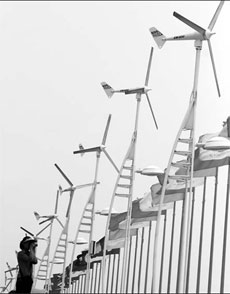

A new cluster of industry is quietly building up in Tianjin, northern China's port and logistics center, as global manufacturers arrive to help supply China's burgeoning wind power industry.
Spanish manufacturer Gamesa, the world's second-largest wind power technology company, opened its first plant in Tianjin last September to assemble nacelles, which hold wind turbines designed for an annual output capacity of 700 megawatts.
But the nacelle assembly line is only the first step in Gamesa's China strategy. It will be followed by a plant to manufacture wind blades.
"By the end of 2007, we will invest 35 million euros in the China industrial project," Guillermo Ulacia, chairman and CEO of Gamesa, tells China Business Weekly.
The Chinese market has become one of the most important markets for Gamesa, with the Tianjin project as its second production plant outside of Spain, Ulacia says.
Investment that poured into wind power last year came not only from Gamesa. Vestas of Denmark and Suzlon of India are also building facilities. Vestas, the world's largest wind turbine manufacturer, says it plans to build Tianjin into its logistic center for the Asia-Pacific region.
The use of wind power, as a clean and renewable energy, has seen rapid growth in China in recent years, as has the businesses of suppliers. By the end of 2006 the total installed capacity of wind power in the country was about 2,600 megawatts. In 2006 alone China added a total of 1,300 megawatts of installed wind power generation.
Energy produced from wind power was 1,266 megawatts in 2005, when there were 61 wind farms in 15 provinces and 1,864 grid-connected turbine generators, said a joint report by the Chinese Renewable Energy Industries Association, Greenpeace and the Global Wind Energy Council.
In April 2007 China Energy Conservation Investment Corp, a large State-owned enterprise, began construction on China's first million-kilowatt wind power project, in Zhangbei, a windy highland between Beijing and Inner Mongolia.
When completed, the project will generate 440 million kilowatt-hours of electricity a year. A total of 1.6 billion yuan has been earmarked for the project.
Compared to a thermal power generator of the same capacity, such a wind farm can save 166,000 tons of standard coal and cut the emission of sulfur dioxide by 7,454 tons and that of carbon dioxide by 395,000 tons annually, says the company.
"This year the nation's wind power industry will continue to see quick growth. In 2007 the installed capacity is expected to be increased by another 1,000 megawatts," says Shi Pengfei, vice-chairman of the Chinese Wind Energy Association (CWEA).
Shi estimates that China possesses a 1,000-gigawatt potential in wind energy, 250 gigawatts on land, mainly in the northwest and the east coast, and 750 gigawatts offshore.
By the year 2020, wind power will have a market value of $1.25 billion, making China potentially the world's largest.
The Chinese government increased its wind power development goal in 2005, raising it from 20,000 megawatts to 30,000 megawatts by the year 2020.
Yet the progress of China's wind power would be faster if domestic suppliers developed technologies to compete with their foreign counterparts, Li Junfeng, deputy director of energy research in National Development and Reform Commission told the China Beijing International Hi-Tech Expo in May.
Imported technology accounted for 77 percent of China's wind turbines and equipment at the end of 2005, according to statistics from CWEA, with foreign manufacturers such General Electric from the United States, Vestas from Denmark and Nordex from Germany dominating the market.
According to Shi, improvements in the world's wind power industry will be needed through increasing turbine capacity, enhancing energy transfer efficiency and decreasing processing costs.
In order to increase generating capacity, the diameter of wind blades needs to be enlarged, Shi says, yet Chinese designs cannot currently accommodate large blades. Wind turbines from China have an output of 750 kilowatts, while most European products have a 2,000-kilowatt capacity.
To provide more power, many foreign wind turbine manufacturers now use a more sophisticated variable-pitch and variable-speed design, while Chinese-made turbines still use an older fixed-pitch and constant-speed system.
"The technology level of China's wind power is 10 years behind developed countries such as Germany and Denmark. If this was compared to the TV industry, the Chinese wind power industry can only produce black and white TV sets, while foreign companies make color TVs," says Shi.
Since wind turbines account for 60 to 70 percent of overall expenses for wind power projects, and the domestic products are about one-third cheaper, embracing the Chinese alternatives can reduce costs while giving a boost to the industry.
Shi believes the key for domestic producers is to build up their own capacity for innovation.
"Without your own research and development capability, you will not know what technologies you should bring in, and you will not know how to implement them even if you have brought them in, let alone make innovations based on them," Shi says, noting that, GoldWind, China's largest domestic turbine manufacturer, has begun to develop new designs.
GoldWind began working with a German design company as early as 2001. By 2005 GoldWind accounted for nearly 90 percent of the total market share increase of domestic companies.
The manufacturer has already tested its own 1,200-kilowatt turbine and is currently designing a 1,500-kilowatt variable pitch model.
(China Daily 06/11/2007 page3)













